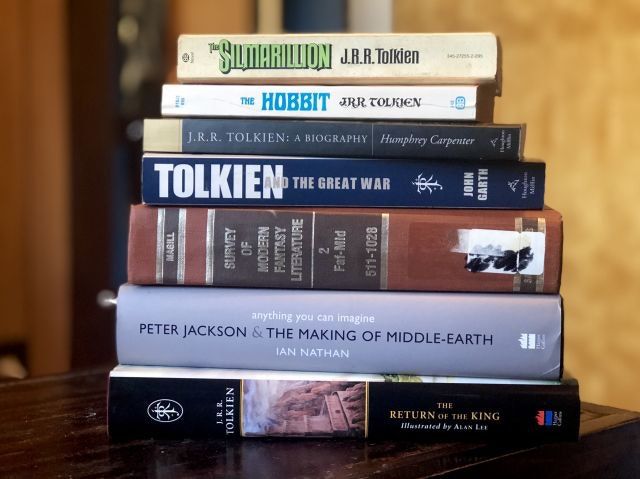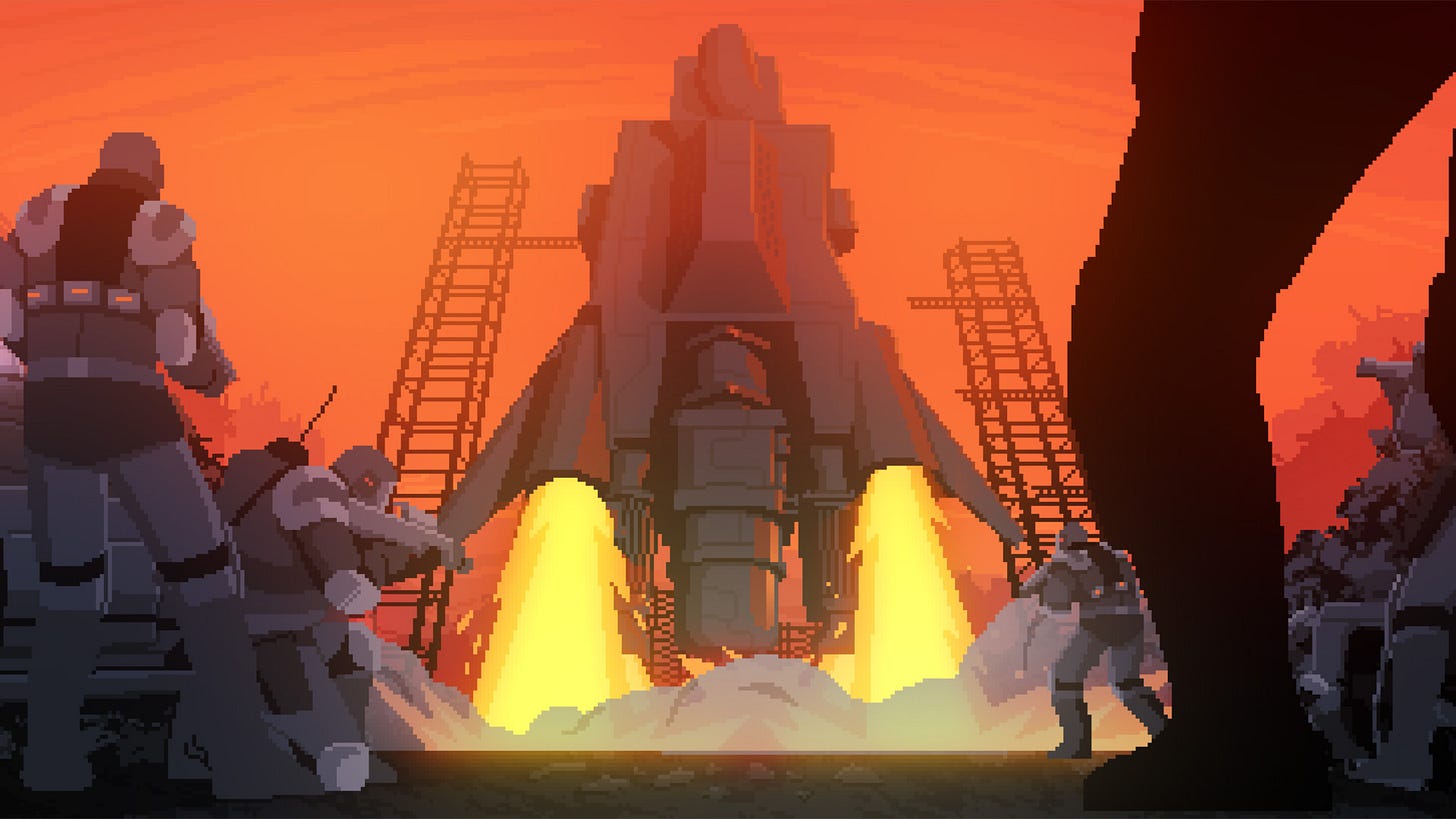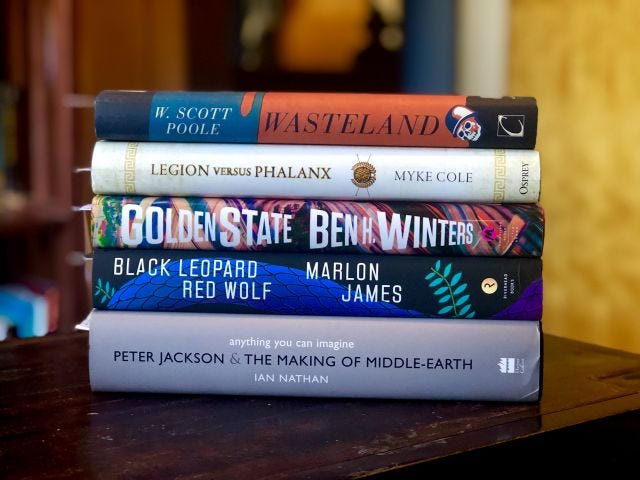Tolkien, Tolkien, Tolkien

Hello!
Apologies for the delay in this latest installment. I was caught up with a bunch of projects at work (which I’ll get to in a moment), as well as a snow storm that’s dumped more than a foot of powder on my literal doorstep. My snow blower decided that this storm was a good time for a cable to snap, so I ended up spending a bit of time tearing the thing apart, locating a replacement part (fortunately, a tractor / snow blower / lawn mower outfit was open), and reinstalling it. This happened last year, too — I had to replace a belt that snapped. It was enough to get me through the weekend storm, but now it's stopped working again, and I think I need to pull it apart ... again. Hopefully, this won't be an annual tradition.
But you know something? I really love doing that. There's a couple of moments where I stare at the machine, bewildered as to why it isn't doing what it's supposed to be doing, before figuring out how to go about figuring out why it broke. That means pulling out socket wrenches and screwdrivers, and pulling the machine apart and figuring out how it works. It's a fun exercise, even though the tools stick to my fingers in the cold — that moment when everything goes back together right (with no parts left over) and it works is a nice feeling.
I don’t have any overarching commentary or anything this time around, but I do have a couple of things that have been on my mind the last couple of weeks.
Better Worlds

A couple of issues ago, I spoke about Better Worlds, an online anthology that at the time, we were about to launch. Well, it’s launched, and it’s pretty awesome. The first four stories are up (or will be today) Justina Ireland’s A Theory of Flight, and Leigh Alexander’s Online Reunion went up last week, while this week, John Scalzi's A Model Dog went up on Monday, and Cadwell Turnbull's story, Monsters in Their Season goes up today. Katherine Cross's Machine of Loving Grace goes up on Friday.
These aren't just stories to be read: Ireland and Scalzi's stories are accompanied by video adaptations (I'm a huge fan of the video for A Theory of Flight), and the ones that don't get videos get audio adaptations, which are really superb productions all around. A ton of kudos go out to my former editor, Laura Hudson, who did a TON of work framing, pitching, and getting this project up off the ground.
Give them a read, and spread the word!
Tolkien, Tolkien, Tolkien
As the subject line says, I’ve been in a bit of a Tolkien mode the last couple of weeks, which has been interesting. I mentioned last letter that I started rewatching Fellowship of the Ring, and I’ve been wanting to get back into the trilogy. I’m still planning on doing that, but not after I’ve finished reading The Hobbit to my son, which has been a delight.
Along the way, I’m still reading Ian Nathan’s deep-dive into the production of the Lord of the Rings and The Hobbit, and it’s kind of a wonder that it was ever made at all. It was an enormously ambitious and complicated project, and it could have been really, really bad. On top of that, I did end up submitting a proposal to the UVM Tolkien conference. Hopefully they’ll accept it. I have a bunch of ideas that I want to explore, which I’ll likely post online even if I don’t get a talking slot.
As I’ve been somewhat immersed in Tolkien’s lore, I’ve been thinking about what the future of Tolkien’s legacy might be. Clearly, there are huge Hollywood ambitious with it. Amazon is spinning up a fantastically expensive show that’s not *quite* an adaptation of LOTR, but which is said to follow Aragorn before the trilogy, which would be… interesting. It’s also supposedly set in Jackson’s particular vision of Middle-earth, which would make sense, given that that’s what the general public is most familiar with. After all, Guillermo del Toro apparently got the ax by deviating too much from Jackson’s world when he went to adapt The Hobbit.
Adapting Middle-earth is a huge challenge, and looking back on Jackson’s efforts on the first trilogy shows just how well they nailed it — Tolkien purists be damned — balancing the need for something accessible while getting the right tone of the world *right*. The Hobbit shows what happens when studios get overly involved and make too many suggestions, ultimately bloating of the film from two to three, and adding in a whole lot of unnecessary plots, characters, and scenes. I’d recommend checking out Lindsay Ellis’s fantastic trio of videos that explores this, and it's reminded me at just how bad the Hobbit trilogy was. It's not that it was loaded down with extra stuff, it's that there were really good things in the middle of the crap. I've got a fan edit of the trilogy, which reduces three movies down to one, which is supposed to be really close to the original novel.
How Amazon tackles this will be something to keep an eye on. Middle-earth is such a huge, vibrant world, and there’s a lot of lore and story to adapt and tell. That’s one of the better parts of The Hobbit trilogy, I thought — bringing it into line with LOTR a bit more, even if it wasn’t executed all that well at times. I do have some issues with going back to this well-established property again, given that there are so many other worlds out there when it comes to bringing fantasy to television. Seriously, someone snap up Brian Staveley’s books for a big-budget show. There’s a lot to play with there.
Plus, Tolkien isn’t the end-all-be-all of fantasy literature, and there are some real issues with it when it comes to things like race and gender portrayals.
Currently reading

My to-read list has grown a bit. That last thought on Tolkien’s portrayal of race and gender leads me to the first book on the list, Marlon James’ upcoming Black Leopard, Red Wolf, which is sort of his take on the big, epic fantasy mythos, drawing from African folklore. It’s quite the read so far, and it’s certainly out there. I’m taking my time with it, but I’m hoping to review it when it hits stores next month.
A little closer to release, I’m digging into Ben H. Winters’ Golden State, his latest since 2016’s Underground Airlines. I’m not liking this one as much as I liked that book, but it’s interesting, and I’ll have some things to say about how dystopias are portrayed. Also on the list is Legion vs. Phalanx by Myke Cole, and Wasteland by W. Scott Poole, about WWI’s impact on the horror genre.
I recently finished Robert Jackson Bennett’s Vigilance, which is a short, biting satire of 2019 America: a sociopathic TV network stands up a reality show where they instigate active shooter situations across America, with prize money given out to anyone who takes down the shooters (or in the event of the shooters killing everyone, they walk away with a huge payout.) There’s a lot in there about ingrained racism and how guns are a particular generation’s way to feel powerful against imagined threats. It’s not particularly subtle, but it doesn’t have to be. Gun nuts will hate it, anti-gun people will read it and nod as they read it. I also blew through JY Yang’s The Black Tides of Heaven, which was fantastic.
After that pile, I’ve got Charlie Jane Anders’s next book, The City in the Middle of the Night, which looks fantastic, as well as JY Yang’s The Descent of Monsters, the latest in their Tensorate novella series. (A fourth is due out this year as well.) I also picked up a book at the bookstore the other day, These Truths: A History of the United States by Jill Lepore, which looks fascinating. Need to read more history this year.
Further reading
Two longer articles caught my eye the last couple of weeks that are worth looking at. The first is a profile of Marlon James in The New Yorker: "Why Marlon James decided to write an African 'Game of Thrones'" which delves into his coming to terms with his sexuality, his writing, and some thoughts on race and speculative fiction:
"...Among the sort of people who pay attention to the Booker Prize, snobbery about wizards and dragons and aliens is increasingly passé. The kind of realism that tends to predominate in literary fiction is “as fantastical as sword and sorcery,” James told me. “The world of a lot of these novels is super white, super middle-class, women only appear in a certain way. That isn’t real life! There are black people on Nantucket! We’ve given social realism this pride of place as the thing with the most verisimilitude, but there’s more verisimilitude in Aesop’s fables. Literary writers don’t get to talk down to sci-fi about invented worlds.”
The next is from Alec Nevala-Lee in The New York Times, a sort of tie-in to his book Astounding that examines the covers of the fabled magazine: "How Asrounding Saw the Future"
During the genre’s golden age, which is conventionally dated from 1939 to 1950, its ideas were refined by a relative handful of authors, editors and artists — and its most immediate impact came through its illustrations. Out of the pulps emerged an entire visual language that relied on striking painted covers to attract newsstand buyers, and while it took years for the stories inside to live up to readers’ dreams, the pictures were often unforgettable from the beginning.
Also, this video of a jewel-maker turning a pair of hex nuts into a diamond ring is really awesome and well worth 12 minutes of your time.
Okay, that’s it for me. Back to dealing with snow and work and stuff. Thanks to everyone who’s signed up for this letter and for reading (spread the word!). I really appreciate it, and the responses that you guys have sent back.
Andrew